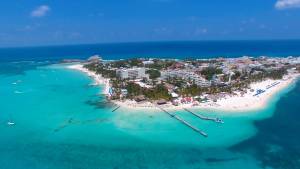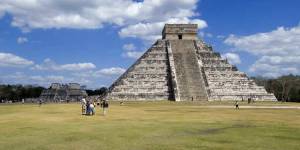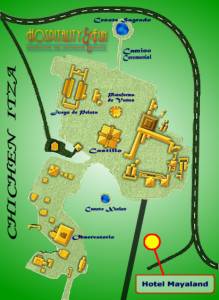As my fiftieth birthday approached, I felt entitled to a vacation. With encouragement from the husband of a friend, I decided to visit a small island off the coast of Mexico’s Yucatan Peninsula. It was not uncommon for Texans to go south of the border, but my excursions there had been limited—Acapulco in 1984, and Mexico City and Nogales in 1994. The latter two were done as part of my research for Coming to Texas / International Students at the University of Texas.
Not so bold
Fifteen years have passed, and I frankly do not remember how I went about setting up this trip. By some means, I secured round-trip airfare between Austin and Cancun, with four nights in nearby Isla Mujeres and a side trip to Chichen Itza. Some people think the traveling I do around Korea these days is daunting or even courageous, but I promise you it’s not. In much the same way, my Mexican vacation took only a little bit of adventurous spirit, a little bit of guts. This was not to be confused with traversing the Sahara or climbing the Alps.
Sometime in the summer of 2002, I flew over the Gulf of Mexico and landed in the Yucatan. While standing in line at the Cancun airport, I met an American lady who talked like she had seen it all—been making these trips twice a year since the 1970s and so forth—and was ready for her to zip it. My passport duly stamped, I boarded a bus that took us to Cancun, and most people got off there. I fully  understood why. I hesitate to criticize Cancun, but it’s not for me in the same way Las Vegas isn’t. About 50 years ago, the Mexican government could find no private investors, so it went ahead and embarked on a big project to turn a coconut plantation and fishing village into an elite tourist resort. The built-in attraction of miles of sandy, white beaches and the azure blue waters of the Caribbean made for a good start. Since then, Cancun has flourished with seemingly hundreds of luxury hotels, restaurants and other facilities to keep Mexican, American and European tourists happy. It sits at the northern end of the Riviera Maya which includes such spots as Puerto Morelos, Tres Rios, Playa del Carmen and, of course, the island of Cozumel. Those places may have their charms, but my destination was Isla Mujeres, 13 kilometers off the coast. A ferry ride across the water and another short bus ride took me to a hotel that was a far cry from those I had seen in Cancun; it was exactly what I wanted.
understood why. I hesitate to criticize Cancun, but it’s not for me in the same way Las Vegas isn’t. About 50 years ago, the Mexican government could find no private investors, so it went ahead and embarked on a big project to turn a coconut plantation and fishing village into an elite tourist resort. The built-in attraction of miles of sandy, white beaches and the azure blue waters of the Caribbean made for a good start. Since then, Cancun has flourished with seemingly hundreds of luxury hotels, restaurants and other facilities to keep Mexican, American and European tourists happy. It sits at the northern end of the Riviera Maya which includes such spots as Puerto Morelos, Tres Rios, Playa del Carmen and, of course, the island of Cozumel. Those places may have their charms, but my destination was Isla Mujeres, 13 kilometers off the coast. A ferry ride across the water and another short bus ride took me to a hotel that was a far cry from those I had seen in Cancun; it was exactly what I wanted.
Isla Mujeres (“Island of Women”), about 7 x 2 kilometers from northwest to southeast, has strong surf and a rocky coast, although there are several sublime beaches. I swam in a couple of them—although I did no scuba diving or snorkeling—, ate various kinds of seafood, drank beer at a thatch-roofed beach bar and walked the streets. Was it as heavenly as my friend’s hubby had said? Perhaps not, but still quite pleasant and different from my humdrum life back in Austin. The year-round population of Isla Mujeres then was about 10,000. Easily my most vivid memory is of the three-hour motor scooter ride I took. My Spanish was sufficient to work a deal with a man to rent his scooter and see far more of the island than otherwise possible. I went put-putting up to the northern tip and then down to the southern tip as stiff winds blew from both sides. The breathtaking scenery notwithstanding, it was all I could do to stay upright. Determined to avoid a motor scooter accident, I rode slowly and cautiously.
The winners of this game die
 On the third day of my little sojourn, I returned to the mainland. At the appointed time, I was at a hotel to join a group of people. We would be led by a tour guide to Chichen Itza, almost 200 kilometers west. This 12-hour side trip lent considerable gravitas to what would otherwise have been merely an enjoyable vacation. Chichen Itza had been one of the mythical great cities of the Mayan civilization before the arrival of Columbus and other Europeans in the New World. I climbed to the top of the big but crumbling pyramid known as the Temple of Kukulcan. In the central chamber, my fellow tourists and I
On the third day of my little sojourn, I returned to the mainland. At the appointed time, I was at a hotel to join a group of people. We would be led by a tour guide to Chichen Itza, almost 200 kilometers west. This 12-hour side trip lent considerable gravitas to what would otherwise have been merely an enjoyable vacation. Chichen Itza had been one of the mythical great cities of the Mayan civilization before the arrival of Columbus and other Europeans in the New World. I climbed to the top of the big but crumbling pyramid known as the Temple of Kukulcan. In the central chamber, my fellow tourists and I  were enthralled and yet horrified to learn that human sacrifice was such a normal part of Mayan ceremonial life. Oh, it was an honor to have a priest make an incision and then rip your heart out? Or to be thrown to an almost certain death at the Sacred Cenote or “Well of Sacrifice?” Or what about the ritualized games played at the Ball Court in which winners—not losers, but winners—were put to death? You can be certain we asked numerous questions about these and related matters. A different time and different culture, yes, but that was just eerie.
were enthralled and yet horrified to learn that human sacrifice was such a normal part of Mayan ceremonial life. Oh, it was an honor to have a priest make an incision and then rip your heart out? Or to be thrown to an almost certain death at the Sacred Cenote or “Well of Sacrifice?” Or what about the ritualized games played at the Ball Court in which winners—not losers, but winners—were put to death? You can be certain we asked numerous questions about these and related matters. A different time and different culture, yes, but that was just eerie.
We ate a sumptuous dinner at the Mayaland Hotel before returning to our respective hotels. In my remaining time on Isla Mujeres, I savored the beauty of the place, swam once more and got ready to leave. The next day, just slightly sunburned, I was back in Austin.


Add Comment